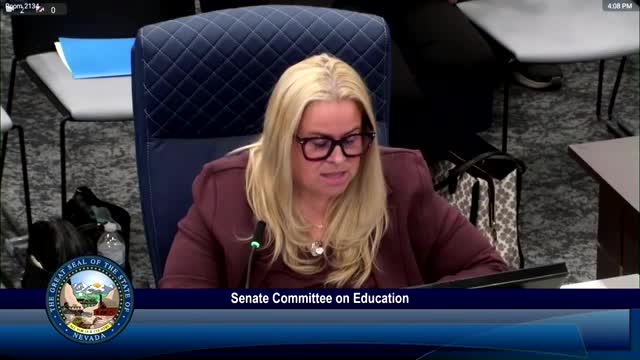Clark County educators advocate for SB 460 to address teacher shortages
May 19, 2025 | 2025 Legislature NV, Nevada
This article was created by AI summarizing key points discussed. AI makes mistakes, so for full details and context, please refer to the video of the full meeting. Please report any errors so we can fix them. Report an error »

The Nevada Senate Committee on Education convened on May 19, 2025, to discuss critical issues surrounding teacher qualifications and educational standards in the Clark County School District (CCSD). The meeting highlighted the urgent need for legislative support to ensure that every classroom is staffed with fully licensed educators, particularly in light of rising teacher vacancies and increasing administrative positions.
One of the key discussions centered on Senate Bill 460 (SB 460), which aims to establish a more balanced ratio of teachers to administrators in public schools. Sherry Griggs, a Title 1 pre-kindergarten teacher and a long-time member of the Clark County Education Association, emphasized the detrimental impact of having unqualified personnel in classrooms. She shared alarming anecdotes about special education classes lacking consistent instruction due to a reliance on substitutes and untrained staff, which has left students without the necessary support to succeed academically.
Griggs pointed out that while there has been a 30% increase in the number of assistant principals in CCSD, teacher vacancies remain high. This imbalance raises concerns about the quality of education students receive, as many classrooms are not led by licensed teachers. The committee heard testimonies underscoring the importance of accountability shared between teachers and administrators, with a call for legislative action to prioritize hiring qualified educators.
The discussions also touched on the importance of early childhood education and literacy programs, which are seen as foundational for student success. Advocates stressed that parents often lack the resources to prepare their children for school, making early intervention programs essential.
In conclusion, the committee's deliberations on SB 460 reflect a growing recognition of the challenges facing Nevada's education system. The proposed bill aims to address staffing issues and ensure that all students have access to qualified teachers, which is crucial for improving educational outcomes. As the committee moves forward, the implications of these discussions will likely resonate throughout the state, influencing future educational policies and funding decisions.
One of the key discussions centered on Senate Bill 460 (SB 460), which aims to establish a more balanced ratio of teachers to administrators in public schools. Sherry Griggs, a Title 1 pre-kindergarten teacher and a long-time member of the Clark County Education Association, emphasized the detrimental impact of having unqualified personnel in classrooms. She shared alarming anecdotes about special education classes lacking consistent instruction due to a reliance on substitutes and untrained staff, which has left students without the necessary support to succeed academically.
Griggs pointed out that while there has been a 30% increase in the number of assistant principals in CCSD, teacher vacancies remain high. This imbalance raises concerns about the quality of education students receive, as many classrooms are not led by licensed teachers. The committee heard testimonies underscoring the importance of accountability shared between teachers and administrators, with a call for legislative action to prioritize hiring qualified educators.
The discussions also touched on the importance of early childhood education and literacy programs, which are seen as foundational for student success. Advocates stressed that parents often lack the resources to prepare their children for school, making early intervention programs essential.
In conclusion, the committee's deliberations on SB 460 reflect a growing recognition of the challenges facing Nevada's education system. The proposed bill aims to address staffing issues and ensure that all students have access to qualified teachers, which is crucial for improving educational outcomes. As the committee moves forward, the implications of these discussions will likely resonate throughout the state, influencing future educational policies and funding decisions.
View full meeting
This article is based on a recent meeting—watch the full video and explore the complete transcript for deeper insights into the discussion.
View full meeting